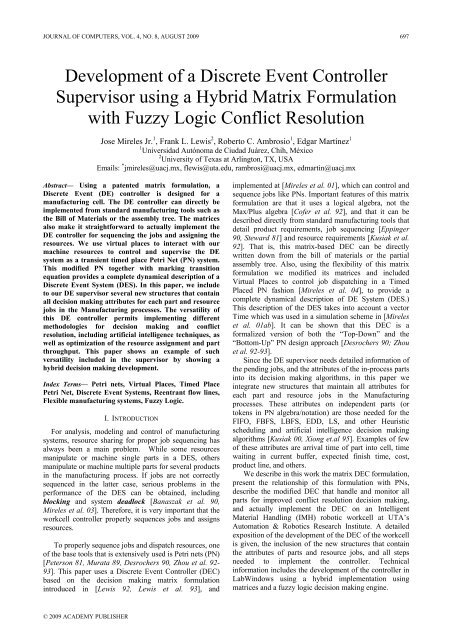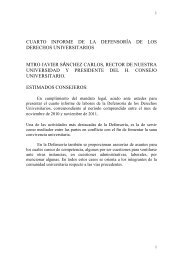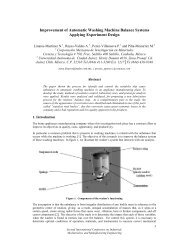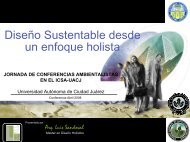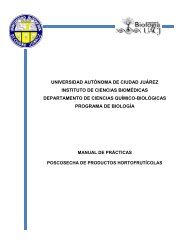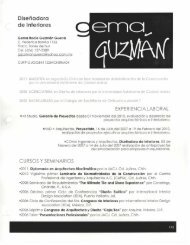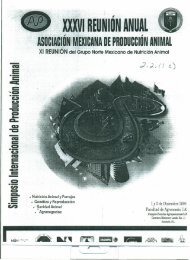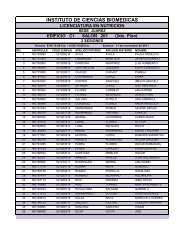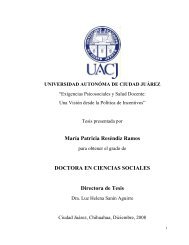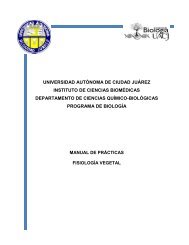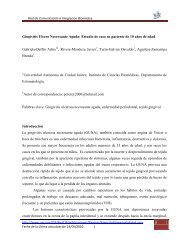journal of computers issn 1796-203x - Universidad Autónoma de ...
journal of computers issn 1796-203x - Universidad Autónoma de ...
journal of computers issn 1796-203x - Universidad Autónoma de ...
You also want an ePaper? Increase the reach of your titles
YUMPU automatically turns print PDFs into web optimized ePapers that Google loves.
JOURNAL OF COMPUTERS, VOL. 4, NO. 8, AUGUST 2009 697<br />
Development <strong>of</strong> a Discrete Event Controller<br />
Supervisor using a Hybrid Matrix Formulation<br />
with Fuzzy Logic Conflict Resolution<br />
Jose Mireles Jr. 1 , Frank L. Lewis 2 , Roberto C. Ambrosio 1 , Edgar Martínez 1<br />
1 <strong>Universidad</strong> <strong>Autónoma</strong> <strong>de</strong> Ciudad Juárez, Chih, México<br />
2 University <strong>of</strong> Texas at Arlington, TX, USA<br />
Emails: * jmireles@uacj.mx, flewis@uta.edu, rambrosi@uacj.mx, edmartin@uacj.mx<br />
Abstract— Using a patented matrix formulation, a<br />
Discrete Event (DE) controller is <strong>de</strong>signed for a<br />
manufacturing cell. The DE controller can directly be<br />
implemented from standard manufacturing tools such as<br />
the Bill <strong>of</strong> Materials or the assembly tree. The matrices<br />
also make it straightforward to actually implement the<br />
DE controller for sequencing the jobs and assigning the<br />
resources. We use virtual places to interact with our<br />
machine resources to control and supervise the DE<br />
system as a transient timed place Petri Net (PN) system.<br />
This modified PN together with marking transition<br />
equation provi<strong>de</strong>s a complete dynamical <strong>de</strong>scription <strong>of</strong> a<br />
Discrete Event System (DES). In this paper, we inclu<strong>de</strong><br />
to our DE supervisor several new structures that contain<br />
all <strong>de</strong>cision making attributes for each part and resource<br />
jobs in the Manufacturing processes. The versatility <strong>of</strong><br />
this DE controller permits implementing different<br />
methodologies for <strong>de</strong>cision making and conflict<br />
resolution, including artificial intelligence techniques, as<br />
well as optimization <strong>of</strong> the resource assignment and part<br />
throughput. This paper shows an example <strong>of</strong> such<br />
versatility inclu<strong>de</strong>d in the supervisor by showing a<br />
hybrid <strong>de</strong>cision making <strong>de</strong>velopment.<br />
In<strong>de</strong>x Terms— Petri nets, Virtual Places, Timed Place<br />
Petri Net, Discrete Event Systems, Reentrant flow lines,<br />
Flexible manufacturing systems, Fuzzy Logic.<br />
I. INTRODUCTION<br />
For analysis, mo<strong>de</strong>ling and control <strong>of</strong> manufacturing<br />
systems, resource sharing for proper job sequencing has<br />
always been a main problem. While some resources<br />
manipulate or machine single parts in a DES, others<br />
manipulate or machine multiple parts for several products<br />
in the manufacturing process. If jobs are not correctly<br />
sequenced in the latter case, serious problems in the<br />
performance <strong>of</strong> the DES can be obtained, including<br />
blocking and system <strong>de</strong>adlock [Banaszak et al. 90,<br />
Mireles et al. 03]. Therefore, it is very important that the<br />
workcell controller properly sequences jobs and assigns<br />
resources.<br />
To properly sequence jobs and dispatch resources, one<br />
<strong>of</strong> the base tools that is extensively used is Petri nets (PN)<br />
[Peterson 81, Murata 89, Desrochers 90, Zhou et al. 92-<br />
93]. This paper uses a Discrete Event Controller (DEC)<br />
based on the <strong>de</strong>cision making matrix formulation<br />
introduced in [Lewis 92, Lewis et al. 93], and<br />
© 2009 ACADEMY PUBLISHER<br />
implemented at [Mireles et al. 01], which can control and<br />
sequence jobs like PNs. Important features <strong>of</strong> this matrix<br />
formulation are that it uses a logical algebra, not the<br />
Max/Plus algebra [C<strong>of</strong>er et al. 92], and that it can be<br />
<strong>de</strong>scribed directly from standard manufacturing tools that<br />
<strong>de</strong>tail product requirements, job sequencing [Eppinger<br />
90, Steward 81] and resource requirements [Kusiak et al.<br />
92]. That is, this matrix-based DEC can be directly<br />
written down from the bill <strong>of</strong> materials or the partial<br />
assembly tree. Also, using the flexibility <strong>of</strong> this matrix<br />
formulation we modified its matrices and inclu<strong>de</strong>d<br />
Virtual Places to control job dispatching in a Timed<br />
Placed PN fashion [Mireles et al. 04], to provi<strong>de</strong> a<br />
complete dynamical <strong>de</strong>scription <strong>of</strong> DE System (DES.)<br />
This <strong>de</strong>scription <strong>of</strong> the DES takes into account a vector<br />
Time which was used in a simulation scheme in [Mireles<br />
et al. 01ab]. It can be shown that this DEC is a<br />
formalized version <strong>of</strong> both the “Top-Down” and the<br />
“Bottom-Up” PN <strong>de</strong>sign approach [Desrochers 90; Zhou<br />
et al. 92-93].<br />
Since the DE supervisor needs <strong>de</strong>tailed information <strong>of</strong><br />
the pending jobs, and the attributes <strong>of</strong> the in-process parts<br />
into its <strong>de</strong>cision making algorithms, in this paper we<br />
integrate new structures that maintain all attributes for<br />
each part and resource jobs in the Manufacturing<br />
processes. These attributes on in<strong>de</strong>pen<strong>de</strong>nt parts (or<br />
tokens in PN algebra/notation) are those nee<strong>de</strong>d for the<br />
FIFO, FBFS, LBFS, EDD, LS, and other Heuristic<br />
scheduling and artificial intelligence <strong>de</strong>cision making<br />
algorithms [Kusiak 00, Xiong et.al 95]. Examples <strong>of</strong> few<br />
<strong>of</strong> these attributes are arrival time <strong>of</strong> part into cell, time<br />
waiting in current buffer, expected finish time, cost,<br />
product line, and others.<br />
We <strong>de</strong>scribe in this work the matrix DEC formulation,<br />
present the relationship <strong>of</strong> this formulation with PNs,<br />
<strong>de</strong>scribe the modified DEC that handle and monitor all<br />
parts for improved conflict resolution <strong>de</strong>cision making,<br />
and actually implement the DEC on an Intelligent<br />
Material Handling (IMH) robotic workcell at UTA’s<br />
Automation & Robotics Research Institute. A <strong>de</strong>tailed<br />
exposition <strong>of</strong> the <strong>de</strong>velopment <strong>of</strong> the DEC <strong>of</strong> the workcell<br />
is given, the inclusion <strong>of</strong> the new structures that contain<br />
the attributes <strong>of</strong> parts and resource jobs, and all steps<br />
nee<strong>de</strong>d to implement the controller. Technical<br />
information inclu<strong>de</strong>s the <strong>de</strong>velopment <strong>of</strong> the controller in<br />
LabWindows using a hybrid implementation using<br />
matrices and a fuzzy logic <strong>de</strong>cision making engine.


